Abstract
Skin metastases are rare in the routine clinical practice of dermatology, but are of major clinical significance because they usually indicate advanced disease. We reviewed the literature on skin metastasis regarding recent trends in clinical presentation and diagnosis of the most common cutaneous lesions. An extensive literature review was conducted using PubMed from May 26, 2011 to July 16, 2013 relating cutaneous metastases. Articles chosen for reference were queried with the following prompts: “Cutaneous metastases”, “clinical presentation”, “histological features”, and “immunohistochemistry”. Further searches included “treatment” and “management” options for “metastatic breast”, “metastatic colorectal”, “metastatic melanoma”, “metastatic lung”, and “hematologic cancers.” We also reviewed the literature on the current management of melanoma as a model for all cutaneous metastatic disease. Our own clinical findings are presented and compared to the literature. Additionally, we highlight the most useful immunohistochemical studies that aid in diagnoses. Several novel therapies and combination therapies such as electrochemotherapy, vemurafenib, and imiquimod will be discussed for palliative treatment of cancers that have been found to improve cutaneous lesions. We review these notable findings and developments regarding skin metastases for the general dermatologist.
Keywords: Cutaneous metastasis, Images, Immunohistochemistry, Skin metastasis
Introduction
Cutaneous metastases are encountered in 0.7-0.9% of cancer patients.[1] They may be the first manifestation of metastatic spread of an internal malignancy[2] or herald cancer recurrence long after treatment of a primary tumor.[3] Patterns of cutaneous metastases vary among women and men. Breast cancer, colorectal cancer, and melanoma frequently metastasize to the skin in women.[4,5] In men; melanoma, lung cancer, and colorectal cancer are the most common sources of cutaneous metastases.[2,4] However, such patterns may differ geographically as a study in Taiwan found internal malignancies metastasize to the skin with different frequencies and at rates differing from primarily Caucasian populations.[6,7] An extensive literature review was conducted using PubMed from May 26, 2011-July 16, 2013 relating cutaneous metastases. Articles chosen for reference were queried with the following prompts: “Cutaneous metastases”, “clinical presentation”, “histological features”, and “immunohistochemistry”. Further searches included “treatment” and “management” options for “metastatic breast”, “metastatic colorectal”, “metastatic melanoma”, “metastatic lung”, and “hematologic cancers”. We review the literature on clinical presentation, diagnosis, and advances in the management.
Clinical Presentation
Cutaneous metastases can present as a great masquerader of underlying disease. A high index of clinical suspicion is critical for diagnosis of skin metastases. Cutaneous metastases may be asymptomatic or be associated with pain and tenderness [Figure 1a]. They frequently present as a rapidly growing painless dermal or subcutaneous nodules with intact overlying epidermis [Figures 1b–d],[8] but can also mimic an inflammatory dermatosis.[9] Metastases may also present as macules, infiltrated or indurated plaques, discoid lesions, tumor nodules with telangiectasias, bullous or papulosquamous lesions, scarred plaques, or pigmented tumors.[3] While there is no single diagnostic characteristic which predominates; a few patterns have been recognized.
Figure 1.
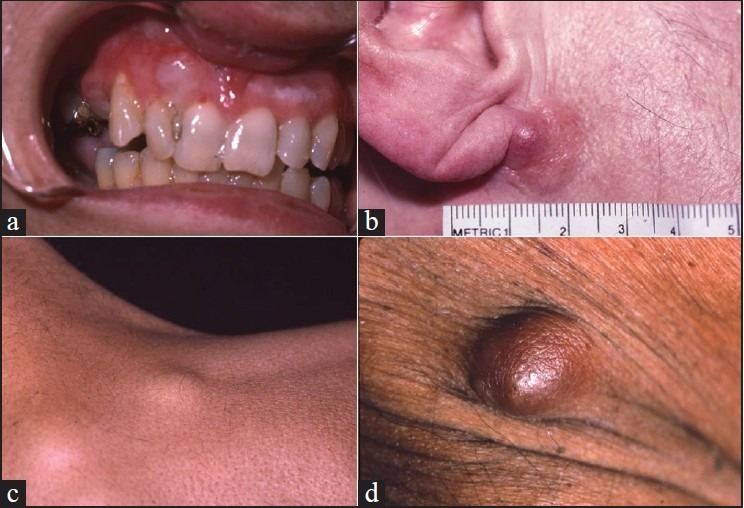
(a) Gingival metastases from a primary chondrosarcoma.(b) Firm nodule at the base of the ear from a primary lung cancer. (c) Two subcutaneous firm nodules in the clavicular fossa from metastatic lung cancer. (d) Isolated firm nodular lesion from metastatic colon cancer
Metastases originating from breast cancer tend to appear in the anterior chest wall, either from direct extension of underlying tumor or by lymphatic spread [Figures 2a and 3a]. Extensive cutaneous involvement of metastatic breast cancer can simulate cellulitis (carcinoma erysipeloides) or a breast-plate of armor ("en cuirasse" pattern). Interestingly, a subset of breast cancer patients has superior prognosis, even among breast cancer patients with stage IV disease.[10]
Figure 2.
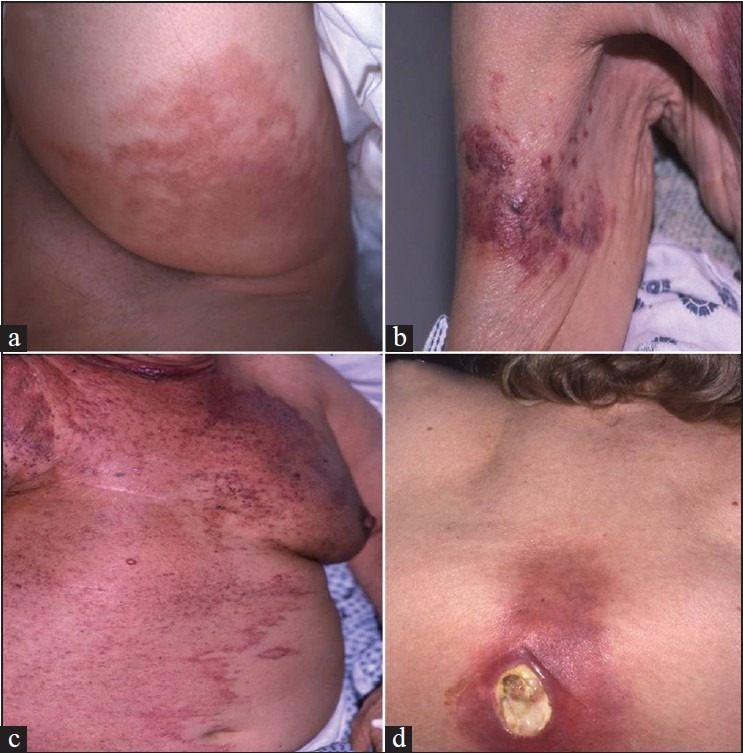
(a) Cellulitis-like appearance of metastatic breast cancer.(b) Plaque-like area with multiple nodules from a primary breast cancer. (c) Massive recurrence of breast cancer on the chest wall and abdomen of the “en cuirasse” type. (d) Breast cancer, metastatic to the thoracic spine with extension to the skin, and lceration secondary to radiation therapy
Figure 3.
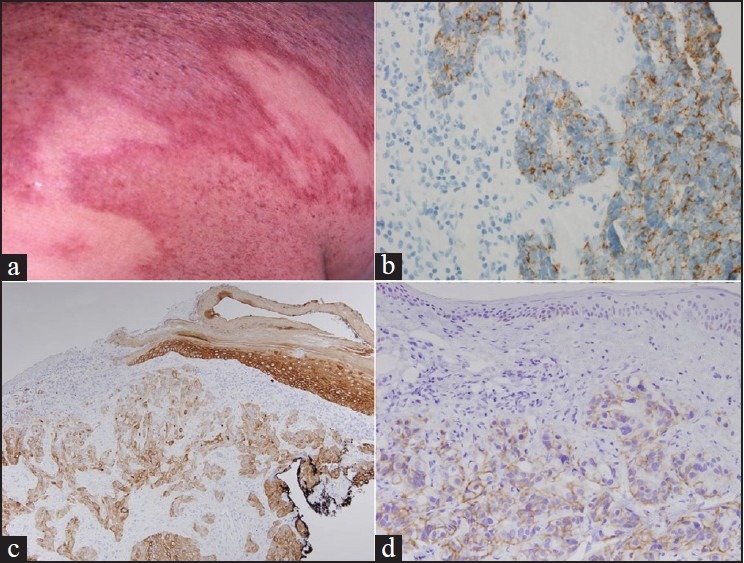
(a) Cellulitic-type appearance with multiple nodules in metastatic breast cancer of the shoulder and upper back. (b) Merkel cell carcinoma reveals neoplastic cells in the dermis. A CAM 5.2 stain reveals perinuclear staining (original magnification, 400×).(c) Metastatic squamous cell carcinoma of the skin reveals neoplastic cells in the dermis (cytokeratin 5/6 stain; original magnification, 100×). (d) Neoplastic cells are noted in the dermis. A HER2/neu stain is positive and decorates the neoplastic cells in the dermis indicating possible metastasis from breast carcinoma (original magnification, 200×)
While most cancers present as solitary nodules, melanoma and carcinomas with an unknown primary frequently present as multiple nodules.[8] Locoregional melanocytic metastases may be explained by angiotropism, an extravascular migratory phenotype, and an important marker and prognostic factor of metastasis in melanoma.[11] The face and scalp are most commonly affected by metastases, suggesting that blood vessels and patterns of innervation may influence the spread of metastases.[12] These patterns can also been associated with cancers of gastric, pulmonary, prostatic, ovarian, laryngeal, palatine-tonsillar, pancreatic, colorectal, parotid, thyroid, or uterine origin and may suggest local treatments that work for melanoma may also work for other metastatic cutaneous malignancies.[13,14,15,16] Tumors may even metastasize into other tumors, causing diagnostic conundrums.[17] When metastases are suspected, punch or excisional biopsy is indicated for definitive diagnosis.
Diagnosis and Immunohistochemistry
Cutaneous metastases often exhibit histological patterns characteristic of the underlying causative primary tumor. Tumors are identified microscopically as a dermal deposit of pleomorphic cells. Mitotic figures are usually evident and neoplastic cells may be identified within vascular lumina. Although metastases may be comprised of cells which are more undifferentiated than the primary tumor, careful examination usually reveals important clues. For example, melanoma is associated with pigment in at least some of the neoplastic cells in most cases. Squamous cell carcinoma is associated with keratin pearl formation, and adenocarcinomas usually exhibit gland formation. Thyroid cancer may exhibit colloid bodies, colon cancer may be associated with mucinous cells, and other tumors may exhibit telltale clues as to their origin. When confronted with a possible metastasis, comparison with the histologic appearance of any prior malignant neoplasms is usually one of the first steps that may help identify the source. Additionally, studies have indicated the majority of metastatic cancers to the skin are adenocarcinomas.[10,18] When tumors are poorly differentiated or anaplastic, screening immunohistochemical studies can be very helpful.
Table 1 identifies immunohistochemical properties of some primary cancers.[19,20,21,22] When neoplastic cells stain with cytokeratin markers such as AE1/AE3 and CAM 5.2, a carcinoma is likely [Figure 3b]. Staining with CD45/leukocyte common antigen (LCA) indicates that neoplastic cells are of lymphoid origin, while S-100, Melan-A, Mart-1, HMB-45, and SOX-10 decorate most melanomas. More detailed immunohistochemical studies [Table 2] can be performed when screening studies and clinical correlation have not been fruitful in identifying a tumor of origin.[23,24] Although advances in immunohistochemistry are very promising, there is still much work that needs to be done to characterize metastases.[25,26,27] A recent letter to the editor highlights the pitfalls that can occur when differentiating primary cutaneous apocrine carcinoma from a metastasis.[28] Although cytokeratin 5/6 is associated with cutaneous apocrine carcinoma, this staining pattern has also been noted with metastatic squamous cell carcinoma [Figure 3c]. Similarly, cytokeratin 7 usually stains metastases diffusely, but is associated with only focal staining in primary adnexal carcinoma, but this pattern is not absolute.[29] Mammaglobin is of interest as it is associated with more widespread staining of metastases than primary apocrine carcinoma, but the results are still preliminary.[30] CD10 staining has been associated with tumor progression.[24] Cyclooxygenase 2 is associated with tumors of the mid-gut (ileum and appendix), gut, colorectal adenocarcinoma as well as gastroesophageal adenocarcinoma.[31] Staining of adenocarcinoma of the lung and endometrioid adenocarcinoma can also occur, highlighting the fact that all immunochemical marker studies must be interpreted in the context of other findings.[31] When an epithelial carcinoma is identified, cytokeratin 7 and 20 stains can provide important useful characterization of tumors. Additional testing can include thyroid transcription factor-1 (TTF-1) and other markers as needed. When clinical appearance, clinical history, and the histologic findings on biopsy are all taken into account, the cause of most skin metastases becomes clear. Unfortunately, there are still many cases that elude precise diagnosis regarding whether a tumor is primary or metastatic. Recent reports have proposed a diagnostic algorithm for metastatic tumors of unknown primary.[25,26,27,32] Until better methods are developed, the biologic behavior becomes the ultimate arbiter in such cases.
Table 1.
Screening immunophenotypes of undifferentiated neoplasm
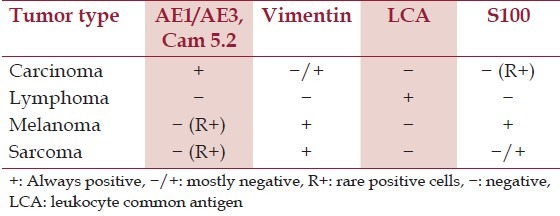
Table 2.
Immunohistochemistry studies for metastatic tumor of unknown origin
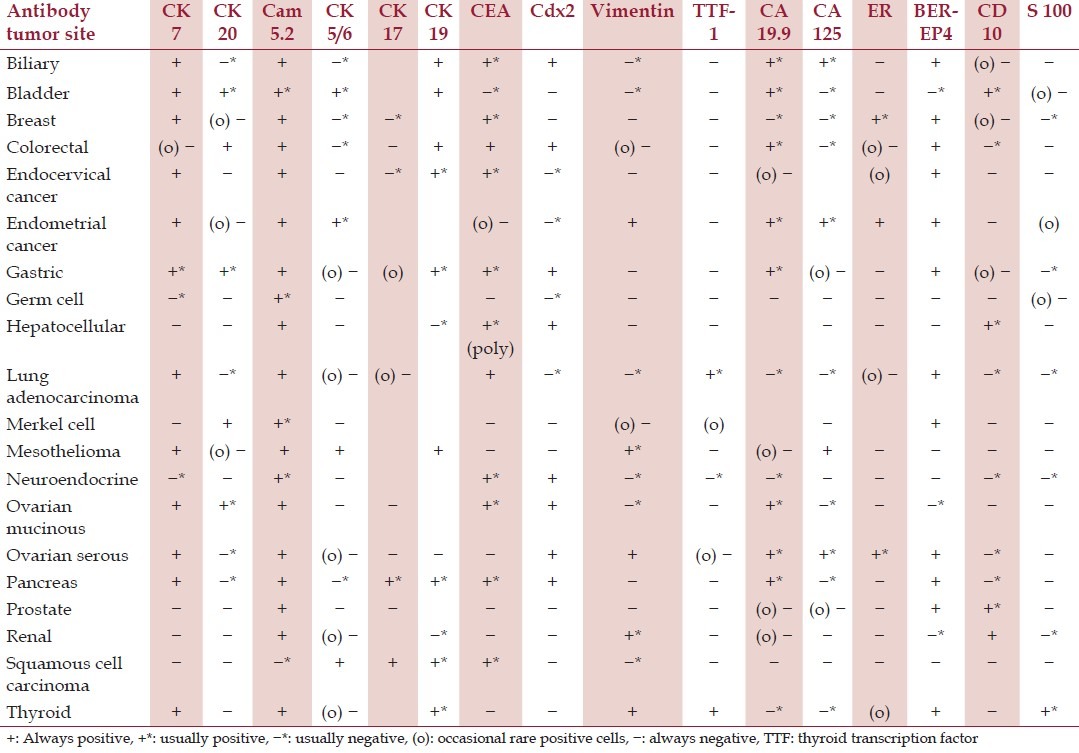
Current Advances in Prognosis and the Management
We recommend excising metastases when surgically feasible and when this will result in a significant decrease in total tumor burden, improve quality of life, or result in increased functionality. Novel treatments have had a profound effect on prolonging the survival and improving quality of life with metastatic cancer. Oftentimes, treatment of the primary cancer with a successful regimen will cause cutaneous lesions to lessen.
Interestingly, the abscopal response represents an unusual response to radiation therapy in which radiation of a tumor causes untreated distant skin lesions to dissipate without recurrence.[33] The pathophysiology and mechanism of the abscopal effect have not been well-defined, but one study used monoclonal antibodies to analyze infiltrating lymphocytes and suggested that the abscopal effect was caused by activated cellular immunity.[34] The abscopal response has been reported with treatment of melanoma, Merkel cell carcinoma, hematologic, and solid tumors.[33]
The study of effective local treatments for melanoma may serve as a model for other malignancies that disseminate via lymphatics and the blood stream to the skin. For melanomas, we typically excise isolated metastases with a 1 cm margin of normal skin, understanding that there are no evidence based studies looking at the utility of margins for metastatic disease. In areas of high cosmetic importance or when therapy is limited to palliation, we sometimes perform excisions with very limited margins. Therapy for patients with widespread cutaneous and subcutaneous metastases of advanced melanoma that are nonresectable is limited to other types of palliative therapy. Options include radiotherapy, systemic chemotherapy, polychemotherapy, isolated limb perfusion, interferon alpha injections, cryotherapy, laser ablation, or radiofrequency ablation.[35]
Electrochemotherapy is a novel therapeutic option based on enhanced drug delivery into cancer cells using externally applied electrical fields that increase cell membrane permeability.[36,37,38,39] Using targeted electric pulses on tumor-specific areas, cytotoxicity of cisplatin increased 80 times and bleomycin 8,000 times with a large reduction in systemic side effects.[40,41] A study comparing tumor nodules treated with electrochemotherapy with cisplatin versus cisplatin alone found at a 124-week follow-up, 77% of control rate of tumor nodules treated with electrochemotherapy was observed compared to 19% for those treated with cisplatin only.[42] Electrochemotherapy is well-tolerated by patients, highly effective with low doses of cisplatin or bleomycin, has a short duration of treatment sessions, insignificant side effects, and is more cost-effective than isolated limb perfusion, radiotherapy, interferon-alpha, and hyperthermia associated with radiotherapy and chemotherapy.[42,43,44]
Oncogene-targeted therapy for metastatic melanoma using vemurafenib (PLX4032) for melanoma associated with a mutation of the BRAF gene V600 mutation results in complete or partial tumor regression in the majority of patients with an estimated median progression-free survival of more than 7 months.[45] Side effects include arthralgia, rash, nausea, photosensitivity, fatigue, cutaneous squamous-cell carcinoma, pruritus, and palmoplantar dysesthesia.[45]
Imiquimod 5% cream has also been used successfully in the treatment of metastatic melanoma that is difficult to remove by surgery. In one report, a 58-year-old woman with a superficial spreading melanoma with a Breslow thickness 0.75 mm was treated with wide local excision followed by flap reconstruction. Melanoma reemerged 14 months later that was treated with wide local excision followed by split-thickness graft repair. The patient was enrolled in a melanoma peptide vaccine trial 5 months later without improvement.[46] Twenty-one months later, the patient was treated with imiquimod 5% cream and histopathologic evaluation revealed regression of the widespread cutaneous metastases after 6 months of imiquimod.[46]
Conclusion
Cutaneous metastases can be the first sign of tumor metastases. Any change in the skin should raise the suspicion of metastases in the correct clinical context. Biopsy is mandatory in patients with a history of cancer or those with at high risk of cancer. Immunohistochemical screening methods continue to improve and assist in diagnosing the primary tumors of origin. Immunohistochemical findings can also help direct treatment options. With advances in novel therapies that prolong survival, prompt recognition of cutaneous metastases can help greatly in reducing morbidity and mortality.
Footnotes
Source of Support: Nil.
Conflict of Interest: None declared.
References
- 1.Spencer PS, Helm TN. Skin metastases in cancer patients. Cutis. 1987;39:119–21. [PubMed] [Google Scholar]
- 2.Molina Garrido MJ, Guillén Ponce C, Soto Martínez JL, Martínez Y Sevila C, Carrato Mena A. Cutaneous metastases of lung cancer. Clin Transl Oncol. 2006;8:330–3. doi: 10.1007/s12094-006-0178-6. [DOI] [PubMed] [Google Scholar]
- 3.Nashan D, Müller ML, Braun-Falco M, Reichenberger S, Szeimies RM, Bruckner-Tuderman L. Cutaneous metastases of visceral tumours: A review. J Cancer Res Clin Oncol. 2009;135:1–14. doi: 10.1007/s00432-008-0432-0. [DOI] [PubMed] [Google Scholar]
- 4.Cidon EU. Cutaneous metastases in 42 patients with cancer. Indian J Dermatol Venereol Leprol. 2010;76:409–12. doi: 10.4103/0378-6323.66584. [DOI] [PubMed] [Google Scholar]
- 5.Marcoval J, Moreno A, Jucglà A, Servitje O, Peyrí J. Prostatic adenocarcinoma with cutaneous metastases overlying oestrogen-induced gynaecomastia. Clin Exp Dermatol. 1998;23:119–20. [PubMed] [Google Scholar]
- 6.Hu SC, Chen GS, Wu CS, Chai CY, Chen WT, Lan CC. Rates of cutaneous metastases from different internal malignancies: Experience from a Taiwanese medical center. J Am Acad Dermatol. 2009;60:379–87. doi: 10.1016/j.jaad.2008.10.007. [DOI] [PubMed] [Google Scholar]
- 7.Wong CY, Helm MA, Helm TN, Zeitouni N. Patterns of skin metastases: A review of 25 years, experience at a single cancer center. Int J Dermatol. 2013 doi: 10.1111/j.1365-4632.2012.05635.x. [DOI] [PubMed] [Google Scholar]
- 8.Marcoval J, Moreno A, Peyri J. Cutaneous infiltration by cancer. J Am Acad Dermatol, 2007;57:577–80. doi: 10.1016/j.jaad.2007.01.034. [DOI] [PubMed] [Google Scholar]
- 9.Sariya D, Ruth K, Adams-McDonnell R, Cusack C, Xu X, Elenitsas R, et al. Clinicopathologic correlation of cutaneous metastases: Experience from a cancer center. Arch Dermatol. 2007;143:613–20. doi: 10.1001/archderm.143.5.613. [DOI] [PubMed] [Google Scholar]
- 10.Hu SC, Chen GS, Lu YW, Wu CS, Lan CC. Cutaneous metastases from different internal malignancies: A clinical and prognostic appraisal. J Eur Acad Dermatol Venereol. 2008;22:735–40. doi: 10.1111/j.1468-3083.2008.02590.x. [DOI] [PubMed] [Google Scholar]
- 11.Barnhill RL, Kutzner H, Schmidt B, Ali L, Bagot M, Janin A, et al. Atypical spitzoid melanocytic neoplasms with angiotropism: A potential mechanism of locoregional involvement. Am J Dermatopathol. 2011;33:236–43. doi: 10.1097/DAD.0b013e3181f8c0e1. [DOI] [PubMed] [Google Scholar]
- 12.Brownstein MH, Helwig EB. Patterns of cutaneous metastasis. Arch Dermatol. 1972;105:862–8. [PubMed] [Google Scholar]
- 13.Cox SE, Cruz PD., Jr A spectrum of inflammatory metastasis to skin via lymphatics: Three cases of carcinoma erysipeloides. J Am Acad Dermatol. 1994;30:304–7. doi: 10.1016/s0190-9622(94)70028-1. [DOI] [PubMed] [Google Scholar]
- 14.Richetta A, Ottini L, Falchetti M, Innocenzi D, Bottoni U, Faiola R, et al. Instability at sequence repeats in melanocytic tumours. Melanoma Res. 2001;11:283–9. doi: 10.1097/00008390-200106000-00010. [DOI] [PubMed] [Google Scholar]
- 15.Lee SY, Chang SE, Bae GY, Choi JH, Sung KJ, Moon KC, et al. Carcinoma erysipeloides associated with anaplastic thyroid carcinoma. Clin Exp Dermatol. 2001;26:671–3. doi: 10.1046/j.1365-2230.2001.00915.x. [DOI] [PubMed] [Google Scholar]
- 16.Braverman IM. Skin manifestations of internal malignancy. Clin Geriatr Med. 2002;18:1–19. doi: 10.1016/s0749-0690(03)00031-4. [DOI] [PubMed] [Google Scholar]
- 17.Busam KJ, Halpern A, Marghoob AA. Malignant melanoma metastatic to a basal cell carcinoma simulating the pattern of a basomelanocytic tumor. Am J Surg Pathol. 2006;30:133–6. doi: 10.1097/01.pas.0000179118.76904.02. [DOI] [PubMed] [Google Scholar]
- 18.El Khoury J, Khalifeh I, Kibbi AG, Abbas O. Cutaneous metastasis: Clinicopathological study of 72 patients from a tertiary care center in Lebanon. Int J Dermatol. 2013 doi: 10.1111/j.1365-4632.2012.05650.x. [DOI] [PubMed] [Google Scholar]
- 19.Wang NP, Zee S, Zarbo RJ, Bacchi CE. Gown AM: Coordinate expression of cytokeratins 7 and 20 defines unique subset of carcinomas. Appl Immunohistochem. 1995;3:99–107. [Google Scholar]
- 20.Bhargava R. Theranostic and Genomic application. Philadelphia: Saunders/Elsedier; 2010. Immunohistology of metastatic carcinomas of unknown primary, in Diagnostic immunohistochemistry; pp. 206–55. [Google Scholar]
- 21.Wick MR, Patterson JW. Theranostic and Genomic applications, Third, Editor. Philadelphia: Saunders/Elsedier; 2010. Immunohistology of skin tumors, in Diagnostic immunohistochemistry; pp. 464–99. [Google Scholar]
- 22.Pernick N. CD Markers. Accessed March 23, 2012, at http://www.Pathologyoutlines.com .
- 23.Park SY, Kim BH, Kim JH, Lee S, Kang GH. Panels of immunohistochemical markers help determine primary sites of metastatic adenocarcinoma. Arch Pathol Lab Med. 2007;131:1561–7. doi: 10.5858/2007-131-1561-POIMHD. [DOI] [PubMed] [Google Scholar]
- 24.Bilalovic N, Sandstad B, Golouh R, Nesland JM, Selak I, Torlakovic EE. CD10 protein expression in tumor and stromal cells of malignant melanoma is associated with tumor progression. Mod Pathol. 2004;17:1251–8. doi: 10.1038/modpathol.3800174. [DOI] [PubMed] [Google Scholar]
- 25.Su CH, Chang H, Chen CJ, Liu LC, Wang HC, Lane HY, et al. The carcinoembryonic antigen as a potential prognostic marker for neuroendocrine carcinoma of the breast. Anticancer Res. 2012;32:183–8. [PubMed] [Google Scholar]
- 26.Samy N, Ragab HM, El Maksoud NA, Shaalan M. Prognostic significance of serum Her2/neu, BCL2, CA15-3 and CEA in breast cancer patients: A short follow-up. Cancer Biomark. 2010;6:63–72. doi: 10.3233/CBM-2009-0119. [DOI] [PubMed] [Google Scholar]
- 27.Karray-Chouayekh S, Trifa F, Khabir A, Sellami-Boudawara T, Frikha M, Gargouri A, et al. Negative/Low HER2 expression alone or combined with E-cadherin positivity is predictive of better prognosis in patients with breast carcinoma. Histol Histopathol. 2012;27:377–85. doi: 10.14670/HH-27.377. [DOI] [PubMed] [Google Scholar]
- 28.Fernandez-Flores A. The elusive differential diagnosis of cutaneous apocrine adenocarcinoma vs. metastasis: The current role of clinical correlation. Acta Dermatovenerol Alp Panonica Adriat. 2009;18:141–2. [PubMed] [Google Scholar]
- 29.Qureshi HS, Ormsby AH, Lee MW, Zarbo RJ, Ma CK. The diagnostic utility of p63, CK5/6, CK 7, and CK 20 in distinguishing primary cutaneous adnexal neoplasms from metastatic carcinomas. J Cutan Pathol. 2004;31:145–52. doi: 10.1111/j.0303-6987.2004.00147.x. [DOI] [PubMed] [Google Scholar]
- 30.Silva AL, Tomé MJ, Correia AE, Passos-Coelho JL. Human mammaglobin RT-PCR assay for detection of occult breast cancer cells in hematopoietic products. Ann Oncol. 2002;13:422–9. doi: 10.1093/annonc/mdf107. [DOI] [PubMed] [Google Scholar]
- 31.Moskaluk CA, Zhang H, Powell SM, Cerilli LA, Hampton GM, Frierson HF., Jr Cdx2 protein expression in normal and malignant human tissues: An immunohistochemical survey using tissue microarrays. Mod Pathol. 2003;16:913–9. doi: 10.1097/01.MP.0000086073.92773.55. [DOI] [PubMed] [Google Scholar]
- 32.McLemore MS, Huo L, Deavers MT, Curry JL, Torres-Cabala CA, Wang WL, et al. Cutaneous epithelioid angiomatous nodule of the chest wall with expression of estrogen receptor: A mimic of carcinoma and a potential diagnostic pitfall. J Cutan Pathol. 2011;38:818–22. doi: 10.1111/j.1600-0560.2011.01743.x. [DOI] [PubMed] [Google Scholar]
- 33.Cotter SE, Dunn GP, Collins KM, Sahni D, Zukotynski KA, Hansen JL, et al. Abscopal effect in a patient with metastatic Merkel cell carcinoma following radiation therapy: potential role of induced antitumor immunity. Arch Dermatol. 2011;147:870–2. doi: 10.1001/archdermatol.2011.176. [DOI] [PubMed] [Google Scholar]
- 34.Konoeda K. Therapeutic efficacy of pre-operative radiotherapy on breast carcinoma: in special reference to its abscopal effect on metastatic lymph-nodes. Nihon Gan Chiryo Gakkai Shi. 1990;25:1204–14. [PubMed] [Google Scholar]
- 35.Leong SP, Gershenwald JE, Soong SJ, Schadendorf D, Tarhini AA, Agarwala S, et al. Cutaneous melanoma: A model to study cancer metastasis. J Surg Oncol. 2011;103:538–49. doi: 10.1002/jso.21816. [DOI] [PubMed] [Google Scholar]
- 36.Snoj M, Cemazar M, Slekovec Kolar B, Sersa G. Effective treatment of multiple unresectable skin melanoma metastases by electrochemotherapy. Croat Med J. 2007;48:391–5. [PMC free article] [PubMed] [Google Scholar]
- 37.Quaglino P, Quaglino P, Mortera C, Osella-Abate S, Barberis M, Illengo M, et al. Electrochemotherapy with intravenous bleomycin in the local treatment of skin melanoma metastases. Ann Surg Oncol. 2008;15:2215–22. doi: 10.1245/s10434-008-9976-0. [DOI] [PubMed] [Google Scholar]
- 38.Campana LG, Mocellin S, Basso M, Puccetti O, De Salvo GL, Chiarion-Sileni V, et al. Bleomycin-based electrochemotherapy: Clinical outcome from a single institution's experience with 52 patients. Ann Surg Oncol. 2009;16:191–9. doi: 10.1245/s10434-008-0204-8. [DOI] [PubMed] [Google Scholar]
- 39.Mir LM. Therapeutic perspectives of in vivo cell electropermeabilization. Bioelectrochemistry. 2001;53:1–10. doi: 10.1016/s0302-4598(00)00112-4. [DOI] [PubMed] [Google Scholar]
- 40.Orlowski S, Belehradek J, Jr, Paoletti C, Mir LM. Transient electropermeabilization of cells in culture. Increase of the cytotoxicity of anticancer drugs. Biochem Pharmacol. 1988;37:4727–33. doi: 10.1016/0006-2952(88)90344-9. [DOI] [PubMed] [Google Scholar]
- 41.Sersa G, Cemazar M, Miklavcic D. Antitumor effectiveness of electrochemotherapy with cis-diamminedichloroplatinum (II) in mice. Cancer Res. 1995;55:3450–5. [PubMed] [Google Scholar]
- 42.Sersa G, Stabuc B, Cemazar M, Miklavcic D, Rudolf Z. Electrochemotherapy with cisplatin: Clinical experience in malignant melanoma patients. Clin Cancer Res. 2000;6:863–7. [PubMed] [Google Scholar]
- 43.Kis E, Oláh J, Ócsai H, Baltas E, Gyulai R, Kemény L, et al. Electrochemotherapy of cutaneous metastases of melanoma--A case series study and systematic review of the evidence. Dermatol Surg. 2011;37:816–24. doi: 10.1111/j.1524-4725.2011.01951..x. [DOI] [PubMed] [Google Scholar]
- 44.Colombo GL, Matteo SD, Mir LM. Cost-effectiveness analysis of electrochemotherapy with the Cliniporatortrade mark vs other methods for the control and treatment of cutaneous and subcutaneous tumors. Ther Clin Risk Manag. 2008;4:541–8. doi: 10.2147/tcrm.s2780. [DOI] [PMC free article] [PubMed] [Google Scholar]
- 45.Flaherty KT, Puzanov I, Kim KB, Ribas A, McArthur GA, Sosman JA, et al. Inhibition of mutated, activated BRAF in metastatic melanoma. N Engl J Med. 2010;363:809–19. doi: 10.1056/NEJMoa1002011. [DOI] [PMC free article] [PubMed] [Google Scholar]
- 46.Turza K, Dengel LT, Harris RC, Patterson JW, White K, Grosh WW, et al. Effectiveness of imiquimod limited to dermal melanoma metastases, with simultaneous resistance of subcutaneous metastasis. J Cutan Pathol. 2010;37:94–8. doi: 10.1111/j.1600-0560.2009.01290.x. [DOI] [PMC free article] [PubMed] [Google Scholar]


